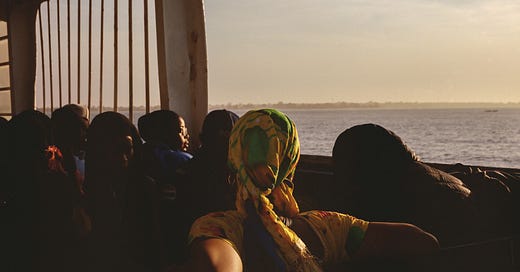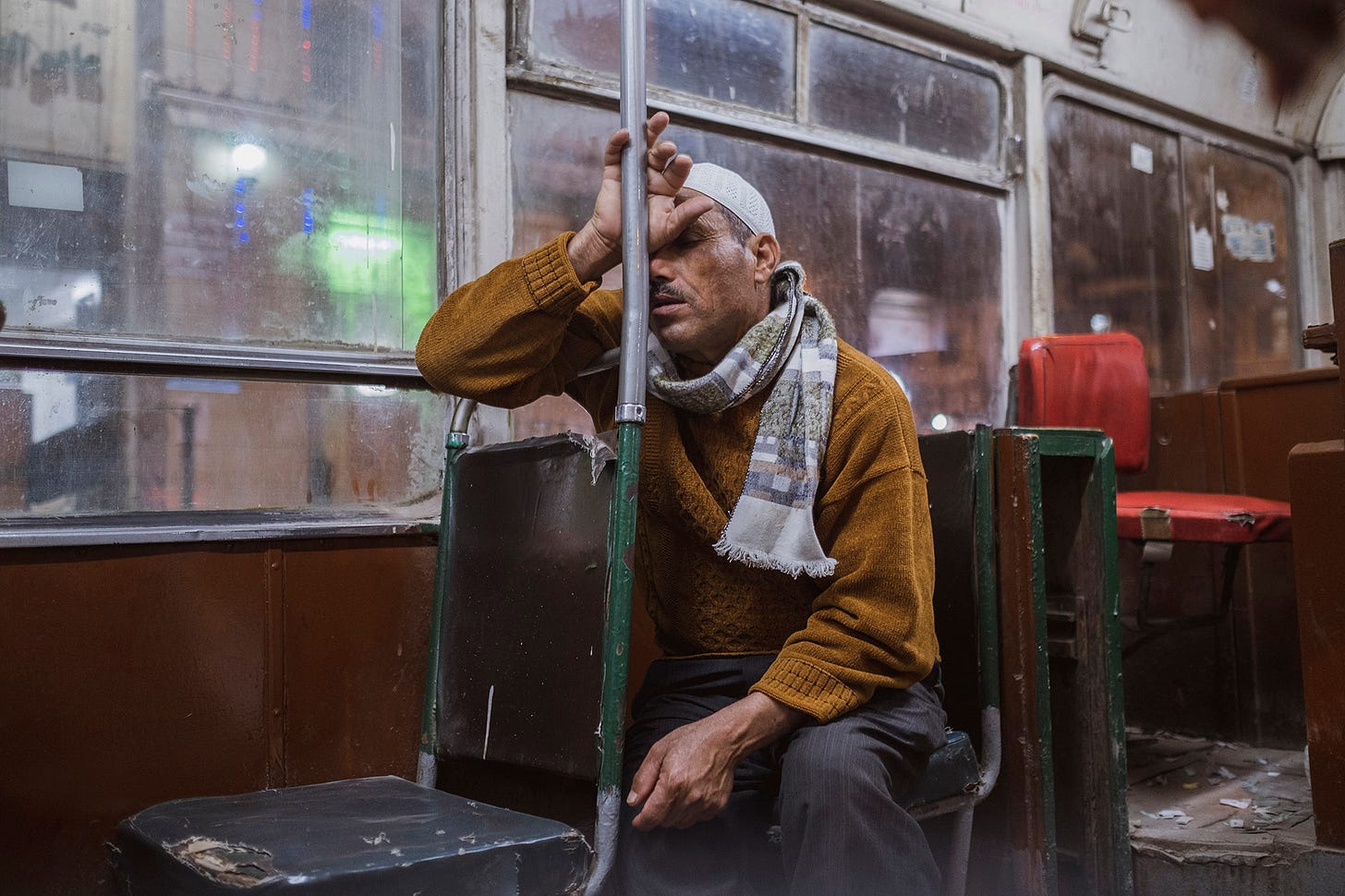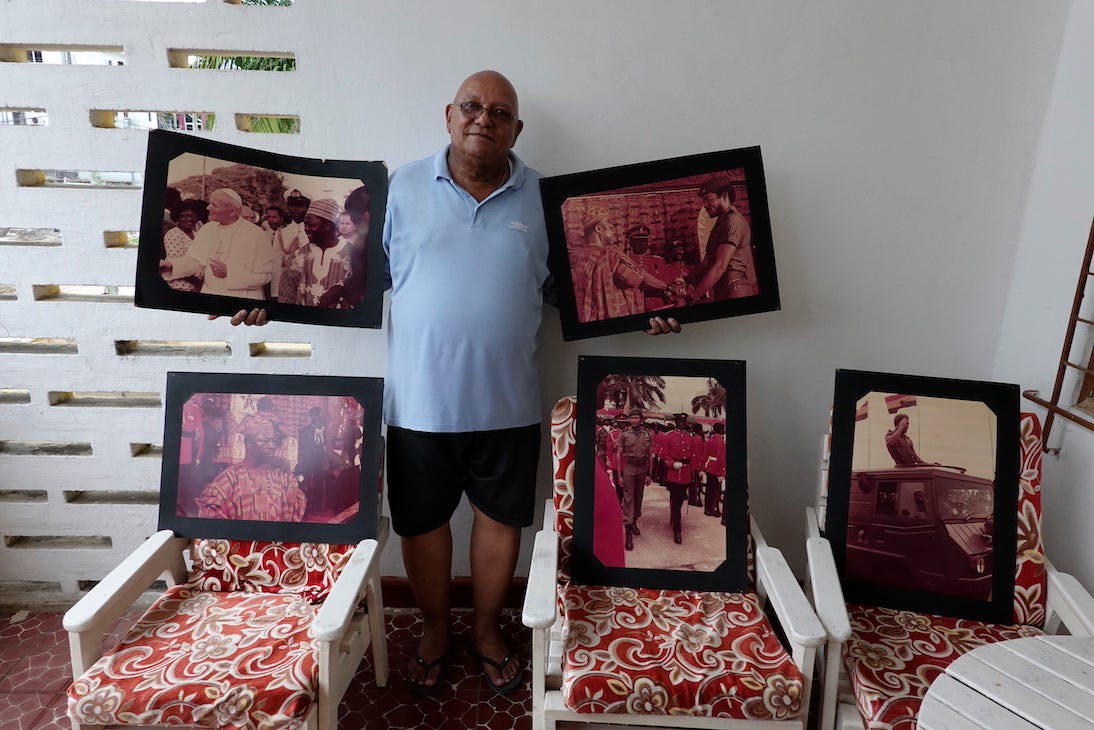As the sun flows towards the sea so does your glance. By a sleight of perspective the closest person to the frame is attired in a scarf close in hue to the light that falls on her elbow. Note, also, the two openings on the right. The one closest to the viewer is without bars of restraint, as wide as an unbarred cliff. It is difficult to tell which sitter is looking at the expanse of water or who is considering the faint line of the approaching shore. This difficulty should not be confused with improbability: despite the dimness of the scene, each head is inclined at just the right angle that you notice the casual and quiet poetry of an everyday commute.
— Emmanuel Iduma
“This project is assisting me in recalling what may have been lost in transition.”
This photograph is from a prior 6am ferry ride from Banjul to Barra, Gambia. I had taken this journey twice before and was deeply observing the daily commuters, wondering where they could be going and coming from. I found myself in a reflective state, thinking about the history of the river and what the waters must have witnessed. Mesmerized by the body of water and the warm golden light of the early hours reflecting off it, I kept thinking about the people who had crossed these same waters around 300 years ago, being carried away into slavery, unsure if these same waters would ever see them return. Observing the people who now willingly commute on the same waters, I try to look for signs of liberation in their body language, what they have brought with them, how they hold these objects, the way they stand or sit on their journey, how they move and interact with each other.
I usually end up in a conversation with a stranger on the ferry, whom I might ask to photograph if it fits well and feels appropriate. However, there are times when I am just like a fly on the wall. For example, if I see a moment, I create the image, and if the person or people in the photograph are identifiable, I then approach them and explain what I am doing. I ask if they are okay with me using the images as part of the project. They usually respond by asking if they can see it, and I explain that I am using an analog camera and ask if they wish for me to send it to them at a later time.
I selected this photograph from my recent project on the continent. This project is enabling me to connect with the motherland, the land of my ancestors. "On Memory" is a project that is assisting me in recalling what may have been lost in transition.
Photography is a means for me to observe my surroundings, preserving what I can and must. It serves as a tool for narrating my own stories and enabling communication without the need for words. What I find most intriguing about photographs is that they represent a two-dimensional rendition of the world we perceive, tangible objects that we can grasp, carry, amass, and safeguard. Photographs possess an enduring lifespan, thus serving as a testament to the past and a means to safeguard narratives and experiences for posterity. Engaging in photography is also a method to remain present within a moment and can be a meditative experience for many.
— Adïam Yemane
About Adïam Yemane
Adïam Yemane is an Ethiopian-Eritrean visual artist and storyteller currently based in London whose work touches on social justice, community development, and the exploration of themes like identity, displacement, and human connection to nature. See more via her website and Instagram.
LAST WEEK
— “Once There Was a Tram,” by Fatma Fahmy
I chose this photograph because I was inside the old tram, and I saw this man with his wife carrying a lot of belongings with them. We were the only passengers in the tram at the time, and his face caught my attention. I took several pictures of him and then struck up a conversation. I asked him about where he was from and showed him the pictures I had taken. I was interested in learning more about his story and the significance of the tram in his life. This encounter was a part of my ongoing interest in capturing the unique and compelling stories of people I come across during my photography journey.
— “On Holding Images,” by Robin Riskin and P.N.O. Ankrah in KINDRED
If we treat the idea of “family” loosely, “Ghana” could be the collective body, and the men in front of and behind the camera could be both its members and narrator/actors. Their political struggles with structure and representation might not be so different from the personal struggle of the widow who mourns her husband. Where lies the fine line between picture-as-potential and picture-as-prison? How do we (learn to) hold onto images, and how do we (learn to) let them go?
This is the 92nd edition of this publication, which also read on web (best for viewing images), and via the Substack iOS/Android apps.
Every Wednesday I feature one photograph and the photographer who took it: you’d read a short caption from me, and a statement from the photographer. Every Friday, I publish a series of commentaries in response to photographs previously featured on the newsletter. The ongoing series is KINDRED. My hope is to engage with early to mid-career African photographers, and to create a platform in which photographers lead the cataloguing and criticism of their work.
Photographers can now submit their work for consideration.
Thank you for reading. If this newsletter was shared with you, consider subscribing, or forward to a friend. Please whitelist the newsletter to ensure you never miss it.







Stunning photograph!